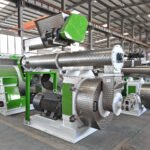In the aquaculture sector, the efficiency and quality of fish feed production are critical to the success of fish farming operations. A fish feed production line with a capacity of 5 tons per hour (t/h) represents a substantial investment for many feed manufacturers. A key consideration when establishing such a production line is understanding the relationship between equipment costs and the level of technical automation. This article examines how these two elements are interconnected and their impact on the overall production process.
Overview of the 5t/h Fish Feed Production Line
A typical 5t/h fish feed production line comprises several essential components:
- Raw Material Handling and Storage Systems
- Grinding Equipment
- Mixing Equipment
- Extrusion System
- Drying and Cooling Equipment
- Coating System
- Packaging Equipment
Each of these components can differ in terms of automation, directly influencing their cost and overall efficiency.
The Automation Spectrum
The level of automation in a fish feed production line can range from basic manual operations to fully automated systems controlled by sophisticated software. Here’s a brief outline of the automation spectrum:
- Manual Systems: Require significant human involvement for operation and monitoring.
- Semi-Automated Systems: Combine manual operations with some automated processes.
- Fully Automated Systems: Operate with minimal human intervention, employing advanced control systems and software.

The Interplay Between Automation and Equipment Costs
In general, there is a positive correlation between the level of automation and equipment costs. As automation levels increase, so does the initial investment required for the equipment. However, this relationship is not strictly linear and can vary based on several factors:
Initial Investment vs. Long-term Savings
While highly automated systems necessitate a larger upfront investment, they often lead to significant cost savings over time. These savings can stem from:
- Decreased labor costs
- Enhanced energy efficiency
- Reduced waste production
- Improved production consistency
For instance, an automated extrusion system for a 5t/h line might cost 30-40% more than a manual system but can cut labor costs by up to 50% and enhance energy efficiency by 15-20%.
Scale of Production
For a 5t/h production line, the advantages of automation can be substantial. At this scale, the enhanced efficiency and consistency provided by automated systems can greatly influence profitability. An automated mixing system, for example, can ensure precise ingredient ratios, resulting in superior feed quality and minimized raw material waste. (Related post:Floating Fish Feed Mill )
Technological Advancements
As technology continues to advance, the costs associated with automation are gradually decreasing, making it more accessible for medium-scale operations such as a 5t/h production line. Modern Programmable Logic Controllers (PLCs) and Internet of Things (IoT) devices are becoming more affordable, allowing for smarter and more efficient production processes.
Customization and Flexibility
Highly automated systems often provide greater flexibility regarding product customization. For a 5t/h fish feed line, this flexibility may entail the ability to quickly switch between different feed formulations for various fish species or growth stages. While this adaptability incurs a higher initial cost, it can enhance market competitiveness and potentially boost revenue.
Quality Control and Consistency
Automated systems typically offer improved quality control and consistency in the final product. In fish feed production, where nutritional content and pellet quality are vital, this enhanced control can justify the higher equipment costs. Advanced sensors and control systems can continuously monitor and adjust production parameters, ensuring consistent feed quality.
Maintenance and Operational Costs
Although automated equipment usually demands a higher initial investment, it often has lower maintenance requirements and operational costs. For example, an automated drying and cooling system might cost 25-35% more than a manual system but can decrease energy consumption by up to 30% and require less frequent maintenance.
Case Study: Automation in Key Components of a 5t/h Fish Feed Line
- Raw Material Handling:
- Manual System Cost: $50,000 – $70,000
- Fully Automated System Cost: $100,000 – $150,000
- Benefits: Enhanced accuracy in ingredient dosing, lower labor costs, improved inventory management
- Extrusion System:
- Basic Extrusion System: $200,000 – $300,000
- Advanced Automated Extrusion System: $350,000 – $500,000
- Benefits: Precise control over temperature and pressure, consistent pellet quality, higher production efficiency
- Drying and Cooling:
- Semi-Automated System: $100,000 – $150,000
- Fully Automated System: $180,000 – $250,000
- Benefits: Optimal moisture content, improved energy efficiency, extended product shelf life
- Control and Monitoring Systems:
- Basic Control System: $30,000 – $50,000
- Advanced Automated Control System: $80,000 – $120,000
- Benefits: Real-time process monitoring, data analytics for optimization, remote operation capabilities
Balancing Costs and Benefits
When evaluating the level of automation for a 5t/h fish feed production line, manufacturers must balance the initial investment against long-term benefits. Key factors to consider include:
- Production Volume: At 5t/h, automation can substantially enhance efficiency and consistency.
- Labor Costs: In areas with high labor costs, automation becomes increasingly appealing.
- Energy Prices: Automated systems typically offer improved energy efficiency, crucial in regions with high energy expenses.
- Market Demands: If the market necessitates high-quality, consistent feed, automation can provide a competitive edge.
- Future Scalability: Investing in automated systems can facilitate easier and more cost-effective future expansions.
Conclusion
There is a significant relationship between equipment costs and the level of technical automation in a 5t/h fish feed pellet production line. Although automated systems generally require a higher initial investment, they offer numerous benefits that can justify the expense, especially at this production scale.
The key to making informed decisions lies in carefully analyzing the specific needs of the operation, local market conditions, and long-term business strategies. For many manufacturers, a balanced approach that integrates automation in critical areas while retaining more manual processes in others may yield the best return on investment.
As technology continues to evolve and become more cost-effective, the trend toward increased automation in fish feed production is expected to persist. Manufacturers who can effectively harness automation while managing costs will be well-positioned to thrive in the competitive aquaculture feed market.











